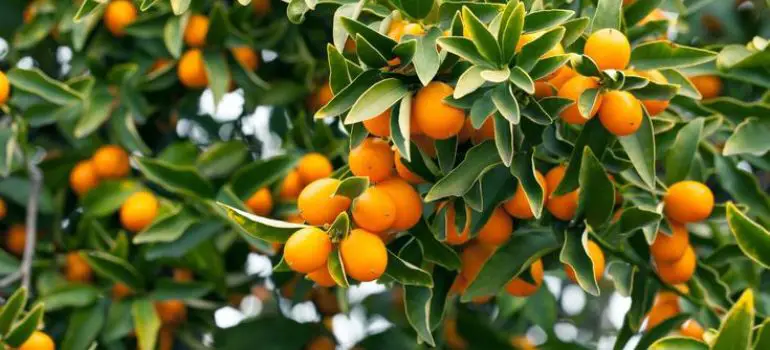Introduction
Kumquats, with their petite size and burst of citrus flavor, have become a sensation in the culinary world. Among the various varieties, Kumquat Meiwa and Nagami stand out for their unique characteristics and taste profiles.
Kumquat Meiwa Characteristics
Kumquat Meiwa, known for its slightly sweet taste and round shape, thrives in subtropical climates. Its bright orange hue and delectable flavor make it a favorite among those seeking a delightful citrus experience. When cultivating Kumquat Meiwa, ensuring well-draining soil and ample sunlight proves crucial for optimal growth.
Nagami Kumquat Characteristics
In contrast, Nagami Kumquat boasts an oblong shape and a more tangy flavor profile. Its thin, edible skin adds a zesty kick to dishes. Nagami Kumquats flourish in similar conditions as their Meiwa counterparts, requiring well-drained soil and plenty of sunlight.
Comparative Analysis
When it comes to the delightful world of kumquats, the distinction between Kumquat Meiwa and Nagami goes beyond mere nomenclature. Let’s dive into a comparative analysis to unravel the unique characteristics that set these two citrus varieties apart.
- Taste Differences
- Kumquat Meiwa: Known for its sweetness, Meiwa resembles a miniature orange, offering a burst of sugary flavor with each bite.
- Nagami Kumquat: Contrasting Meiwa, Nagami leans towards tartness, akin to a miniature lemon, providing a zesty and tangy experience.
- Visual Distinctions
- Kumquat Meiwa: Boasting a round shape and a bright orange hue, Meiwa presents a visually appealing and charming appearance.
- Nagami Kumquat: With its elongated, oblong shape, Nagami captivates with a unique aesthetic, setting it apart from its rounder counterpart.
- Nutritional Variations
- Kumquat Meiwa and Nagami: Both varieties share similarities in nutritional content. Packed with vitamin C, antioxidants, and fiber, they contribute to overall health and well-being.
- Culinary Uses
- Kumquat Meiwa: The sweetness of Meiwa makes it a perfect addition to desserts, jams, and cocktails, enhancing the overall flavor profile.
- Nagami Kumquat: The tartness of Nagami adds a refreshing twist to savory dishes, salads, and marinades, showcasing its versatility in the kitchen.
- Ideal Growing Conditions
- Kumquat Meiwa and Nagami: Both varieties thrive in subtropical climates with well-drained soil and plenty of sunlight. Their cultivation requirements align closely, making them accessible for home gardeners.
- Harvesting Guidelines
- Kumquat Meiwa and Nagami: Harvesting should be done when the fruits reach their full color and easily detach from the tree with a gentle twist. This ensures optimal ripeness and flavor.
- Myths and Misconceptions
- Common Misconceptions about Kumquats: Addressing myths, such as confusing them with other citrus fruits or assuming they are only suitable for marmalades, helps consumers appreciate their distinct qualities.
- Debunking Myths about Nagami Kumquat: Clarifying concerns about the tartness being overwhelming can dispel misconceptions and encourage exploration.
- Consumer Preferences
- Surveys and Studies: Consumer preferences vary, with some favoring Meiwa’s sweetness for desserts and others preferring Nagami’s bold flavor in savory dishes. Market trends indicate a growing interest in incorporating kumquats into various culinary creations.
- Sustainability and Environmental Impact
- Eco-Friendly Cultivation Practices: Both Meiwa and Nagami kumquats can align with sustainable agriculture practices, emphasizing eco-friendly methods to minimize environmental impact.
- Cultural Significance
- Symbolism in Different Cultures: Kumquats hold cultural significance in various traditions, symbolizing prosperity, good luck, and purification. Understanding their cultural context adds depth to the appreciation of these citrus fruits.
In the Kumquat Meiwa vs Nagami conundrum, the choice ultimately depends on personal preferences and culinary inclinations. Whether you savor the sweetness of Meiwa or embrace the tartness of Nagami, both varieties contribute to the rich tapestry of flavors in the citrus world. Explore, experiment, and let your taste buds guide you through the delightful journey of kumquats.
Culinary Uses
Kumquat Meiwa’s sweetness makes it ideal for desserts, jams, and cocktails, enhancing the flavor profile of various dishes. On the other hand, Nagami Kumquat’s tartness adds a refreshing twist to savory dishes, salads, and marinades. Their versatility in the kitchen makes them prized ingredients for both amateur and professional chefs.
Health Benefits

Kumquats, whether Meiwa or Nagami, are not just delightful to the taste buds; they also pack a punch in terms of health benefits. Incorporating these tiny citrus wonders into your diet can contribute to overall well-being in various ways.
- Rich in Vitamin C
- Both Kumquat Meiwa and Nagami are abundant sources of vitamin C, a powerful antioxidant that supports the immune system. Regular consumption can help ward off illnesses and keep your immune defenses strong.
- Boosts Digestive Health
- The fiber content in kumquats aids in digestion and helps maintain a healthy digestive system. Including kumquats in your diet can alleviate issues like constipation and promote regular bowel movements.
- Skin Health
- The antioxidants in kumquats contribute to skin health by fighting free radicals that can damage skin cells. These citrus fruits may help maintain a youthful and radiant complexion.
- Weight Management
- Kumquats are low in calories and high in fiber, making them an excellent snack option for those aiming to manage their weight. The fiber content also provides a feeling of fullness, reducing the likelihood of overeating.
- Blood Pressure Regulation
- The potassium content in kumquats helps regulate blood pressure by counteracting the effects of sodium. Including these fruits in a balanced diet can contribute to cardiovascular health.
- Aids in Detoxification
- Kumquats contain compounds that support liver function, aiding in the body’s natural detoxification processes. Regular consumption may help cleanse the liver and promote overall detoxification.
- Anti-Inflammatory Properties
- The antioxidants in kumquats have anti-inflammatory properties, which can help reduce inflammation in the body. This may be beneficial for those dealing with inflammatory conditions.
- Blood Sugar Control
- The fiber and low glycemic index of kumquats make them a suitable option for individuals looking to control blood sugar levels. Including these fruits in moderation can be part of a diabetic-friendly diet.
- Eye Health
- The presence of nutrients like vitamin A and carotenoids in kumquats contributes to maintaining eye health. These compounds are essential for preserving vision and preventing age-related eye disorders.
- Bone Health
- Kumquats contain minerals like calcium and phosphorus, vital for maintaining strong and healthy bones. Including them in your diet can contribute to bone density and overall skeletal health.
Remember, while kumquats offer numerous health benefits, it’s crucial to incorporate them as part of a balanced and varied diet. As with any dietary changes, it’s advisable to consult with a healthcare professional, especially if you have specific health concerns or conditions. Enjoy the goodness of Kumquat Meiwa and Nagami, and let these citrus gems contribute to your well-being.
Growing and Harvesting Tips
Cultivating Kumquat Meiwa and Nagami Kumquat involves providing well-drained soil, consistent watering, and protection from extreme temperatures. Harvesting should be done when the fruits reach their full color and easily detach from the tree with a gentle twist.
Popular Myths and Misconceptions
Dispelling myths about kumquats, such as confusing them with other citrus fruits or assuming they are only suitable for marmalades, helps consumers appreciate their distinct qualities. Addressing misconceptions about Nagami Kumquat, such as concerns about the tartness being overwhelming, promotes informed choices.
Consumer Preferences
Surveys indicate a diverse range of preferences among consumers, with some favoring the sweetness of Meiwa for desserts and others preferring Nagami for its bold flavor in savory dishes. Market trends suggest a growing interest in incorporating kumquats into various culinary creations.
Sustainability and Environmental Impact
Kumquat cultivation can align with sustainable agriculture practices, emphasizing eco-friendly methods to minimize environmental impact. Exploring organic options and supporting local growers contributes to a more sustainable citrus industry.
Kumquats in Culture and Traditions
These citrus fruits hold cultural significance in various traditions, symbolizing prosperity, good luck, and purification. Incorporating kumquats into ceremonies and celebrations adds a touch of tradition to modern festivities.
DIY Kumquat Gardening
For those eager to embark on a kumquat-growing adventure, starting with a suitable variety, providing proper care, and addressing potential challenges ensures a rewarding experience. Overcoming obstacles, such as pests or adverse weather conditions, is part of the journey to a thriving kumquat garden.
Fun Facts
Did you know that Meiwa and Nagami kumquats belong to the Fortunella genus, named after the botanist Robert Fortune? These citrus fruits have a rich history, dating back centuries, and have evolved into beloved culinary treasures.
Customer Reviews
Real-life experiences shared by consumers highlight the joy of discovering the unique qualities of Kumquat Meiwa and Nagami. Positive feedback often centers around the versatility, freshness, and vibrant flavors these kumquats bring to dishes. Negative feedback may stem from misconceptions or improper handling during storage.
Conclusion
In the debate of Kumquat Meiwa vs Nagami, the winner is ultimately the one that suits individual preferences and culinary aspirations. Whether you lean towards Meiwa’s sweetness or Nagami’s tartness, both varieties offer a delightful journey into the world of citrus.
FAQs
Yes, the skin of kumquats is edible and adds a unique texture to the overall experience.
While rare, some individuals may experience allergic reactions to citrus fruits. It’s advisable to consult with a healthcare professional if you have concerns.
Store kumquats in a cool, dry place or refrigerate them for extended freshness. Use within a few weeks for optimal flavor.
Yes, with proper care and sunlight, you can successfully grow kumquats in containers indoors.
Harvest kumquats when they reach full color, typically in late fall or early winter, depending on the variety.



